Must Know Omnichannel Statistics For Marketers (2025)
Shopping isn’t what it used to be. With all the tech and tools available today, people are mixing online and offline touchpoints like never before. On average, a shopper uses six different channels before hitting the “buy” button. That could mean checking out a product on Instagram, reading reviews, comparing prices online, and then walking into a store to see it in person.
For brands, this shift means one thing, if you’re not meeting customers where they are (they are everywhere btw), then you’re falling behind. An effective omnichannel approach isn’t just a nice-to-have anymore; it’s survival.
Our latest report on omnichannel stats breaks down the who, what, and how behind modern buying habits. It’s your blueprint for building a strategy that actually clicks.
What is Omnichannel? (Definition)
Omnichannel is a strategy where a business uses multiple channels—like online, in-store, social media, and email—to create a seamless and unified customer experience. It ensures that all these channels work together to provide consistent messaging and service.
Omnichannel vs Multichannel – They are not the same!
“Omnichannel” and “multichannel” are often used as if they mean the same thing, but they’re different. The main difference is how easily you can switch between different ways of interacting with a company.
For example, imagine you start browsing products on a company’s website, then ask a question through their mobile app, and later call their customer support. With an omnichannel approach, the company’s system keeps track of your activity across all these channels. The support team can see everything you’ve done and help you without making you repeat yourself.
With a multichannel approach, the company might not connect all your interactions. So, every time you switch channels, you might have to start from scratch, leading to a not so smooth experience.
73% of retail shoppers are omnichannel shoppers
As per a study carried out among 46,000 retail shoppers, 7 out of 10 retail shoppers use multiple channels in their shopping journey. only 7% shop completely online while 20% shop only in physical stores. Most of the online shoppers will also shuffle between a platform’s application and website. Some even go further to explore a platform’s social media store if available.
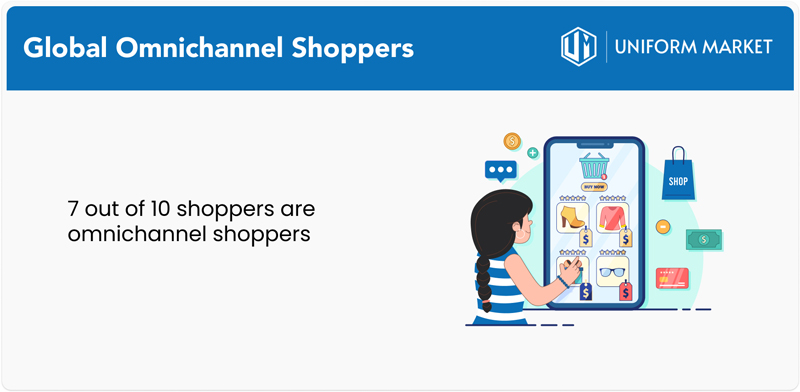
Since the pandemic, more than 33% of Americans have regularly used omni channel00 features like buying online and picking up in-store, and nearly 67% of these individuals plan to keep using these services.
Source: Harvard Business Review.
The majority of shopping journeys start online in 2025
Klarna’s Shopping Pulse report reveals that 83% of shoppers research online before visiting a physical store. While in-store, 72% of shoppers use their smartphones to compare prices or read reviews.
Physical stores are a significant starting point for shopping journeys, with just over one-third of customers beginning their experience there. This is similar in popularity to starting with apps and websites, except for search engines and online stores. Around 25% of shopping journeys start on price comparison websites, with fewer starting through conversations with peers or physical magazines.
Here is a table showing touchpoints where shoppers start their journey in 2025:
| Touchpoint | Share of shoppers |
|---|---|
| Search engine | 44% |
| Online store | 41% |
| Physical store | 36% |
| Browsing websites or apps | 31% |
| Price comparison service | 24% |
| Online marketplaces | 20% |
| Talking to family and friends | 18% |
| Social media | 14% |
| Physical magazines and publications | 7% |
Source: Klarna.
Omnichannel retail media advertising spending in the United States
In 2025, omnichannel retail media advertising spending in the United States—which includes advertising across a retailer’s e-commerce platforms, on-site signage (both in-store and adjacent exterior displays), as well as their media network (RMN) or demand-side platform (DSP) is estimated to account for about 16.3% of the total media advertising expenditure. This share is projected to rise significantly, surpassing 24.4% by 2028.
Source: Statista.
Companies with omnichannel engagement strategies manage to retain 89% of their customers.
Companies with strong omnichannel engagement strategies retain an average of 89% of their customers, while those with weaker strategies only retain about 33% of their customers.
These retained customers also have a greater lifetime value as Shoppers who make purchases both online and in-store are worth 30% more to a business over their lifetime compared to those who only shop using one channel.
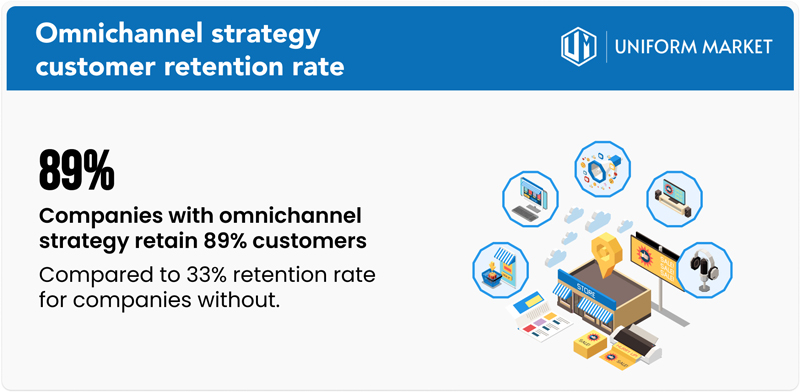
Source: Invespcro.
Marketers operating three or more channels have a 494% higher order rate than single-channel campaign
Marketers who use three or more ways to reach customers, like email, social media, and ads, see a huge boost in orders. Single-channel campaigns have a 0.14% order rate, while campaigns using multiple channels have a 0.83% order rate, which is nearly a five-fold increase.
Source: Omnisend
Companies with powerful omnichannel customer engagement witness a 9.5% YoY increase in annual revenue
Companies with highly effective omnichannel engagement experience a 9.5% annual revenue growth each year, while those with weaker strategies see only a 3.4% increase.
Additionally, businesses with strong omnichannel practices reduce their cost per contact by 7.5% year-over-year, compared to just a 0.2% reduction for companies with less effective strategies.
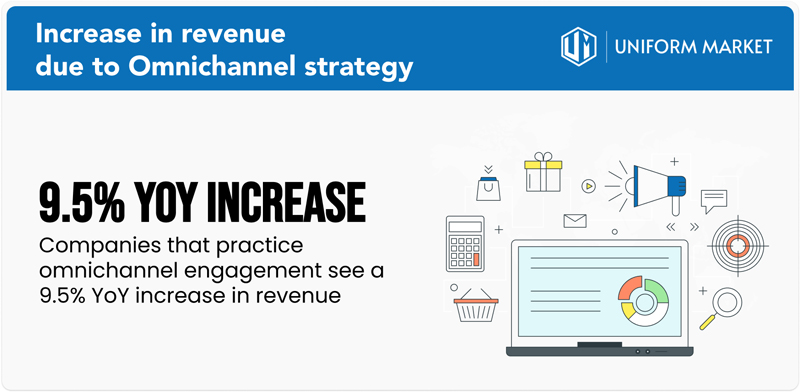
Source: Digital Commerce 360.
The average retail consumer in 2025 wants nearly six touchpoints when making a purchase
Fifteen years ago, the average retail shopper used about two touch-points to make a purchase, with only 7% using more than four. In 2025, shoppers use nearly six touch-points on average with half of the consumers using more than four regularly.
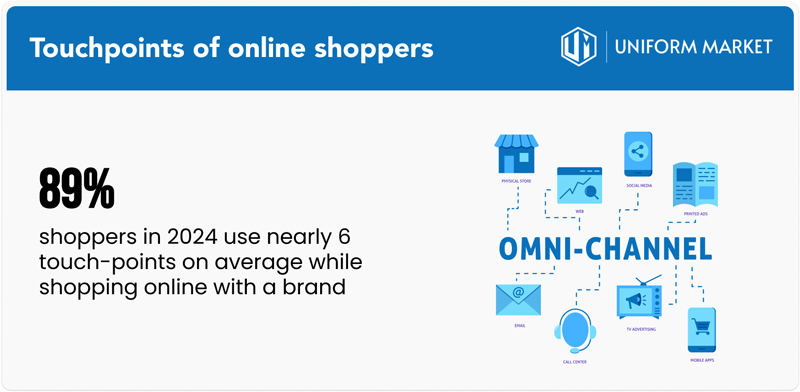
Source: Knexus
Omnichannel strategies generate around 80% more in-store visits from customers
Google’s internal data shows that Omnichannel strategies drive an 80% higher store visits. These customers are reported to spend 4% more when they make a visit to a physical location than single-channel customers.
Source: Google.
72 million Americans are actively using the curbside pickup option
As of January 2025, 72 million Americans used curbside pickup in the last 12 months, representing 25.3% of U.S. consumers. The usage is so significant that Curbside Pickup retail sales in the US are estimated to reach $154.3 billion in 2025.
By integrating online ordering systems with in-store processes, businesses can ensure that orders are prepared and ready on time, and that customers receive real-time updates about their pickups. This connection between online and offline channels helps improve order accuracy and provide a more seamless pickup experience.
Source: Statista.
80% of shoppers use a mobile phone inside a physical store
8 out of 10 shoppers use their mobile phones inside physical stores to check product reviews, compare prices, or locate other store options. As many of these buyers also compare prices on a retailer’s official website or app, businesses should ensure a consistent and high-quality experience across all their channels.
Maintaining uniform pricing, up-to-date product information, and seamless service helps in building trust and eventually better conversions.
Source: eCommerce Times.
83% of consumers say a personalized experience increases brand loyalty
83% of people say they’re more likely to stay loyal to a brand that offers a personalized experience. On the other hand, almost two-thirds of people say they’ll stop buying from a company if it doesn’t personalize their service.
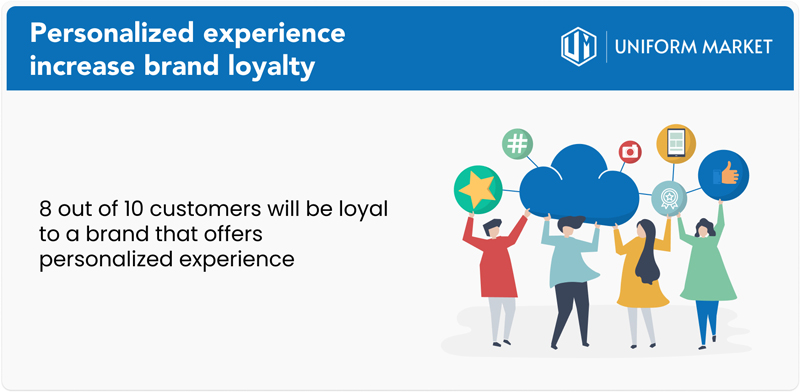
Companies that focus on personalization see an average boost of 46% in how much customers spend. So, it’s clear that creating a tailored shopping experience is good for business.
Source: Twilio.
55% of consumers value the experience offered by physical stores
Even though online shopping is widespread, 55% of consumers still appreciate the hands-on experience of shopping in physical stores. Many people may end up buying online, but their in-store visits and the impressions they get there often play a big role in shaping their final purchase decisions.
Source: Better Commerce
Leading types of data personalization companies use for customer profiling
86% of senior marketing executives globally said demographics is the most important type of data used for customer profiling. Behavioral data came next, with 49%, while data about business details rounded up the top three with 44%.
57% of these marketing executives saw inconsistencies in gathered data as one of the major data-related challenges in providing personalized customer experiences. Unifying data sources stood second, with 48%, while siloed data rounded up the top three with 47%.
Source: Statista
Omnichannel in back to school shopping
This year, 65.1% of back-to-school shopping is expected to be in-store, but online sales are growing faster at 7.4% compared to 1.0% for physical stores. Parents shop in-store for immediate availability (48%), discounts (41%), and better experiences (33%).
Online shoppers prefer the convenience (43%), better prices (37%), and wider selection (36%) offered by eCommerce. Overall, back-to-school sales are set to hit $81.16 billion, a 3.2% increase from last year. Retailers should optimize their strategies across both online and in-store channels.
Source: eMarketer.
79% of business leaders believe customer service should be available across all channels
Your customers are active on various platforms and expect to get help or advice whenever and wherever they need it. That’s why 79% of customer service leaders now prioritize omni-channel support.
Source: Hubspot.
Customers sending direct messages on a business’ social media are increasing
The number of social media users who have sent a direct message for customer service increased by 27% between 2022 and 2023. One in four Gen Z, Millennials, and Gen X say DMs are how they prefer to get customer service from a company.
By syncing order and complaint histories with social media accounts, businesses can provide a seamless experience for customers. This integration helps ensure that customer service interactions are efficient and personalized, reducing the risk of losing customers
Source: Hubspot

Final Say
If you are a retailer, you must adopt an omnichannel strategy to drive growth, boost revenue, and retain customers as it is the only way to go forward. This approach makes you more 2025 relevant and can give you an edge over competitors using fewer channels.
However, it’s crucial to build a strong foundation first and monitor the system continuously. Even minor issues can undermine the benefits, so stay vigilant and responsive to keep your strategy effective.
Ready to launch your next
Employee Program?
Uniform Programs?
Company Stores?
Group Stores?
Team Stores?
Swag Stores?
Brand Stores?
Event Stores?
Distributor Portals?
Enabling uniforms and promotional product suppliers with eCommerce solutions to manage B2B, B2B2C, and Direct selling from one central platform.

